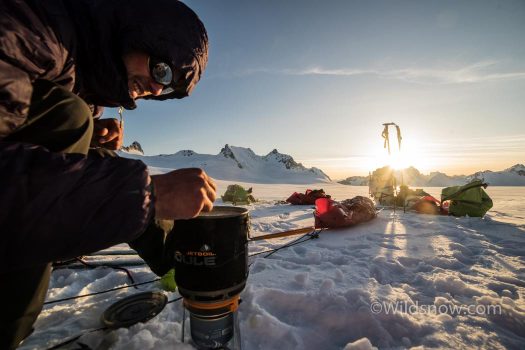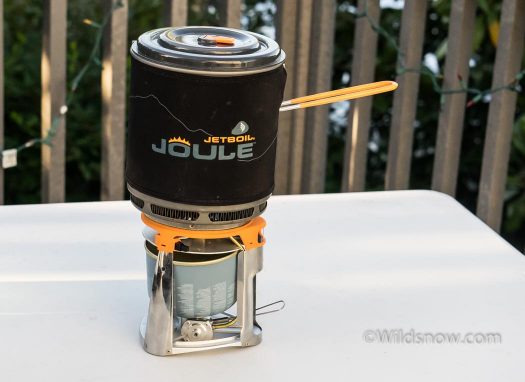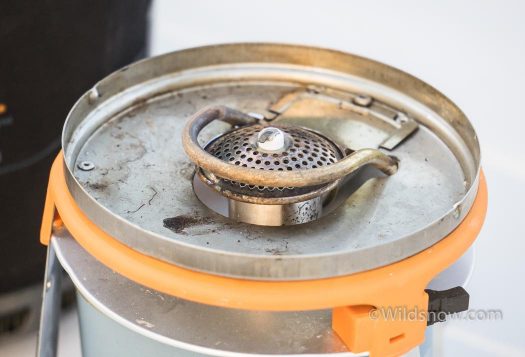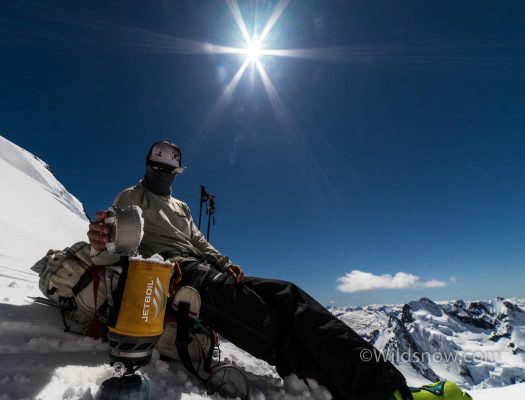I love food — lots of it. I’ve been on a few trips where we didn’t have enough. Those were not fun times. Water is nice too. On a multi-day ski trip, both are impossible without a disaster-proof stove system.
While planning for our Monarch Icefield ski mountaineering trip, Eric, Coop and I went back and forth about what cooking system to bring. Traditionally, white gas stoves are the go-to option for a trip like this. White gas has the advantages of being fully functional in the cold, and easy to carry in large quantities. The best white gas stoves also are powerful snow melters. Unfortunately, it’s difficult (and sometimes dangerous) to light them. They also aren’t very efficient.
Jetboil and other integrated canister stoves, on the other hand, have the advantage of being easy to use and mega efficient if set up with dedicated heat retention systems. As fuel spills are less common and they don’t have a pump to malfunction, they’re also safer in a tent or vestibule (as long as it’s well ventilated). Unfortunately, due to bulky packing cannister fuel isn’t easy to carry in large quantities. The most popular canister stove, Jetboil, also doesn’t traditionally work very well in the cold, and has cooking pots that may be too small for group winter camping.
We ultimately decided on bringing two Jetboil canister stoves; a Jetboil Sumo, and the new Joule stove system. The Joule would be our main stove, with the Sumo as a backup and a lighter option to bring during day trips.
The Joule is a new offering from Jetboil that is more oriented to group expedition use. It is bigger and heavier than normal Jetboil stoves, with a large 2.5 liter pot. The stove orients the fuel canister upside down, and elevates it from the cold ground. The fuel is also routed through a tube that goes past the burner, similar to a white gas stove. All these features eliminate many of the disadvantages that Jetboils have for winter expedition use. It has a huge heat output of 10,000 BTUs, and is still quite efficient. For comparison, the highest heat-output white gas stove I could find maxed out at 10,500 BTUs.
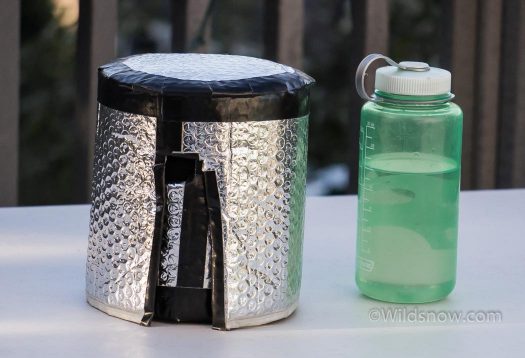
The Joule packed up in it’s insulating coozie. The stove fits neatly inside the pot, with no disassembly.
I’d never used coozie cooking, or cannister stoves on an extended trip, and I was quite interested to see how our system would work. It ended up being an excellent way to go.
We wanted to reduce how much fuel we hauled along with making life easier in camp. To do so, we decided to utilize quick cooking foods along with an insulated pot cover for “coozie cooking.” I fashioned a coozie out of a reflective window shade and duct tape that fit the Joule pot well. We ate granola and milk most mornings, with the occasional hot breakfast. Additionally, only one of us drank coffee in the mornings. We hoped all that would mean that we didn’t use too much fuel throughout the 15 day trip. On the other hand we wouldn’t exactly be sipping fuel as we needed to melt lots of snow, as well as making hot drinks and lunches during storm days.
We estimated our fuel needs, and then erred well on the side of caution. We ended up bringing 8 small 230 gram fuel canisters and 1 large 450 gram canister. That totals to 2290 grams, which is a little over half as much as we would have hauled with white gas at the generous standard of 100 grams of fuel per person per day. Thus, we saved almost 5 pounds of weight by going with the Jetboil. After a few days into our trip, we realized we weren’t using our daily allotment of fuel. Through the rest of the trip we didn’t skimp on fuel usage. Even so, we ended up having 3 full canisters, plus 2 partly full canisters left over at the end of the trip, so we could have conceivably brought even less fuel. This is a significant discovery in terms of reducing overall baggage weight for these big human-powered trips.
The Joule proved to be an excellent stove. It melted snow incredibly fast, and sipped fuel. Although the stove has a very hot burner, it can be turned down very low to simmer. We even managed to make quesadillas in the bottom of the pot without burning them. That is amazing.
We didn’t have any issues with the stove in the cold, even on frigid mornings. The pot size proved to be great for our group size of 3 hungry dudes. We made fairly massive portions of dinner, and didn’t fill up the pot. The Joule is a hefty stove, but it fits inside it’s pot without disassembly, so it was nice and easy to melt water during short rest stops. The size of the stove base also makes it stable. We never needed to use a stove board or anything else to support it in snow. Also, since the burner is quite a ways from the stove base, it doesn’t tend to get hot and melt into the snow.
The Joule system does have some disadvantages and things I would like to see changed. For one, the pot is incompatible with other versions of the Jetboil, and vice versa. In fact, apparently the Joule would potentially melt a hole through another Jetboil pot if you attempted to use one instead instead of the dedicated bucket. Also, the stove only can use the small or medium (230 gram) canisters. This appears to be a necessary compromise, however, to keep the size down and allow the cannister to be inverted. The major issue we experienced was that the piezo lighter mechanism melted. The button is positioned close to the burner — clearly too close — it melted on day 10 of our trip. I’ve had issues with Jetboil Piezo igniters not working in the past, but much to my delight this one worked almost every time — until it melted, anyway.
The Joule pot is a good size and shape, but could use some improvements as well. The lid doesn’t have a pour hole like other Jetboil lids. This is an excellent feature, especially when you’re melting snow and unmelted chunks can mess up your water draw. Also, the handle is flimsy and doesn’t lock closed around the lid securely. It also doesn’t reliably lock in the open position, something important while moving big pots of food unless you want to be licking dinner off your tent floor.
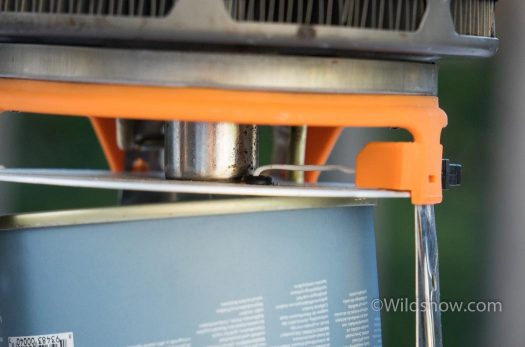
The piezo igniter of the Joule. It’s located super close to the burner, above the plate that separates the fuel canister from the burner.
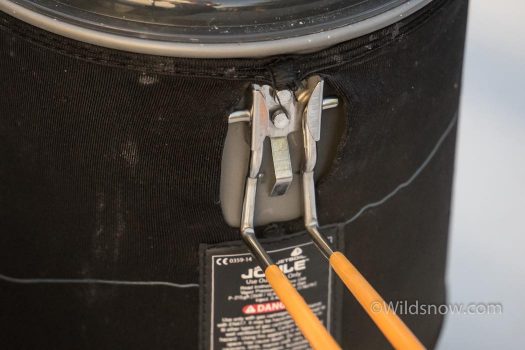
Handle of the Joule pot. It works, but it feels a bit wimpy, and can collapse, especially with a full pot of food.
The Sumo is an older stove made by Jetboil. It is simply a large pot that fits onto the standard Jetboil burner. However, it did come with their newest burner design (reviewed with the MicroMo here). The Sumo is a terrific stove, although the large pot does feel a bit unstable with the small burner. The Joule is a bit too large to comfortably carry on day trips, so we often took the Sumo instead. It is larger than a standard Jetboil, but it is perfect for melting a large amount of snow — or making hot drinks for 3 people. Another nice feature of the Sumo is that the large pot enables the stove to be stored inside fully assembled (with even enough space for a pack of noodles).
Our food system worked well. Dinner consisted of simply boiling water in the Joules big pot, pouring in the ingredients, then putting it in the coozie for 15 minutes. We made some delicious meals this way. It enabled us to save fuel and not spend much time bent over the stove breathing fumes. The combo of the two Jetboil stoves was perfect for this system, as they added ease of use and efficiency. We used the Sumo stove exclusively for melting snow and boiling water, thus keeping the pot clean. The Joule was used primarily for food cooking, but also for melting snow.
Coop and Eric took charge of meal planning and did a fine job. We used “Bear Creek” meal packs, bought at the grocery store, often combined with either instant potatoes, or quick-cooking rice. We also used bulk re-fried beans and supplemented our meals with salami and cheese. Our repasts were focused on being cheap, simple, light, and delicious. For this reason, we didn’t use many basic ingredients, but also didn’t use expensive freeze-dried food.
Shop for Jetboil stove systems.
Louie Dawson earned his Bachelor Degree in Industrial Design from Western Washington University in 2014. When he’s not skiing Mount Baker or somewhere equally as snowy, he’s thinking about new products to make ski mountaineering more fun and safe.

